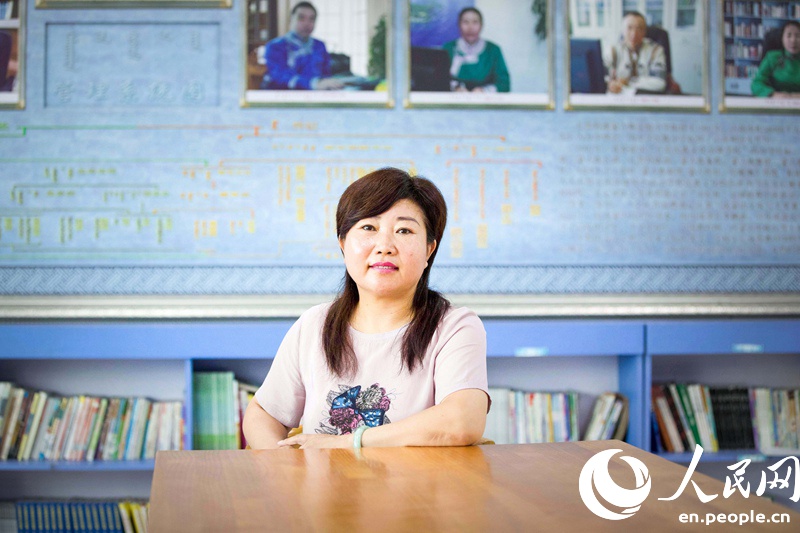


Located in Tongliao, a city that has the largest Mongolian population in China, Jarud Mongolian Primary School is one of the 109 local schools that feature traditional Mongolian culture, as well as using Mongolian as their primary teaching language. [Photo by Tanja Herko]
O. Henry once wrote, "When one loves one's art, no service seems too hard.” Although thirteen-year-old Qinggelt may know nothing about O. Henry, his love for Üliger, the traditional Mongolian art of singing, has shown the truth of this famous statement. Here in Jarud Mongolian Primary School, Qinggelt and his friends have been learning Üliger for over three years, practicing the traditional art on a daily basis.
Dubbed "Mongolian rap," Üliger is a form of traditional art that combines Mongolian music and literature, telling the legends of Mongolian mythological and historical heroes. Üliger performers usually play on a four-stringed fiddle, singing the stories rhythmically.

Art work designed by the students. [Photo by Tanja Herko]
"Üligers are significant in our culture, given their long-standing tradition of passing stories on by word of mouth. I spend many hours every day polishing my singing skills and memorizing the stories, but I feel quite happy about it," said Qinggelt.
Qinggelt is not the only student who has access to traditional Mongolian culture. At his school, which has over 2,300 Mongolian students, nine Mongolian cultural courses are provided to the children, including Mongolian chess, leather carving and dancing.
"Traditional art, like Üligers, are fading in the modern world. I want to learn and promote the art, so that the world can appreciate the beauty and history of our culture," he added.
Tradition matters in school

Qinggelt, along with his classmates, has performed Üliger in many big cities, including Beijing, as well as introducing the art to the public. [Photo by Tanja Herko]
Located in Tongliao, a city that has the largest Mongolian population in China, Jarud Mongolian Primary School is one of the 109 local schools that feature traditional Mongolian culture, as well as using Mongolian as their primary teaching language.
"As a Mongolian myself, I know how important it is to preserve our traditional culture, especially nowadays, when market-oriented popular culture prevails among the young generation," said Kangxima, headmistress of Jarud Mongolian Primary School.
Though traditional Mongolian culture has always been a compulsory course at school, Kangxima invited cultural experts to develop a systematic teaching module for the students. From 2005, Kangxima and her colleagues began researching Mongolian culture, as well as designing a professional course for the students.

Kangxima says it's important to teach traditional culture at her school. [Photo by Tanja Herko]
"Most students in our school are from remote villages. Though they have a love for traditional art, they have minimal resources to learn it. Here in our school, all the courses and equipment are free to students, as long as they have an interest, they are welcomed," said Urentuyaa, the school's Üliger teacher.
The school's traditional cultural education has proven successful. Qinggelt, along with his classmates, has performed Üliger in many big cities, including Beijing, as well as introducing the art to the public.
"I am now carrying the responsibility to preserve Üliger, for which I feel very proud. I hope more people can learn about my culture through my performance," said Qinggelt.
In addition to cultural education, local schools have also attached great importance to language studies. According to local regulations, most courses are taught in Mongolian at Mongolian schools, but students are required to study both Mandarin and English in second and third grade respectively.

Traditional Mongolian engraving painting made by the students. [Photo by Tanja Herko]
"The Mongolian language is our cultural root, Mandarin represents our identity as Chinese, while English makes our students international citizens. By learning three languages, we have triple identities, " said Kangxima, adding that multilingualism and multiculturalism have made her students more culturally tolerant and open-minded, who are now introducing their culture to students from other cultural backgrounds.
"Our school has many exchange programs with schools in Shenzhen and Beijing. From those schools, our kids have learned about traditional Chinese culture and modern technologies, from us, those schools have had a better understanding of traditional Mongolian culture," said Kangxima.

 Award-winning photos show poverty reduction achievements in NE China's Jilin province
Award-winning photos show poverty reduction achievements in NE China's Jilin province People dance to greet advent of New Year in Ameiqituo Town, Guizhou
People dance to greet advent of New Year in Ameiqituo Town, Guizhou Fire brigade in Shanghai holds group wedding
Fire brigade in Shanghai holds group wedding Tourists enjoy ice sculptures in Datan Town, north China
Tourists enjoy ice sculptures in Datan Town, north China Sunset scenery of Dayan Pagoda in Xi'an
Sunset scenery of Dayan Pagoda in Xi'an Tourists have fun at scenic spot in Nanlong Town, NW China
Tourists have fun at scenic spot in Nanlong Town, NW China Harbin attracts tourists by making best use of ice in winter
Harbin attracts tourists by making best use of ice in winter In pics: FIS Alpine Ski Women's World Cup Slalom
In pics: FIS Alpine Ski Women's World Cup Slalom Black-necked cranes rest at reservoir in Lhunzhub County, Lhasa
Black-necked cranes rest at reservoir in Lhunzhub County, Lhasa China's FAST telescope will be available to foreign scientists in April
China's FAST telescope will be available to foreign scientists in April